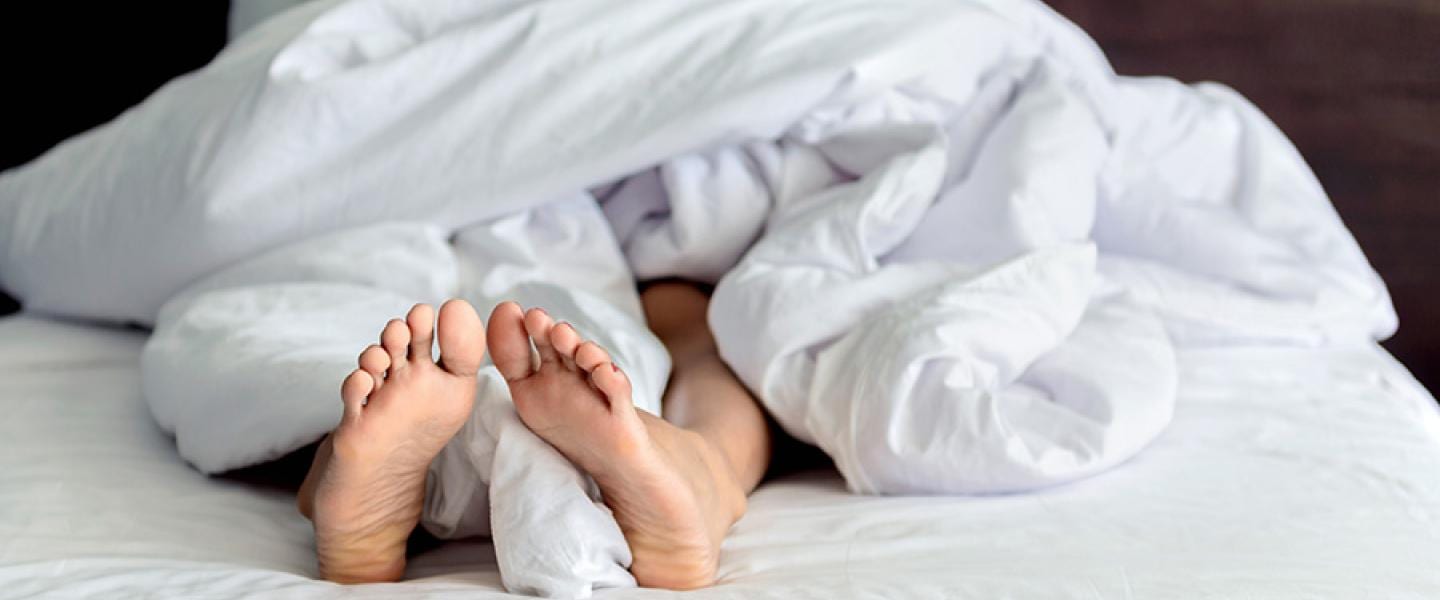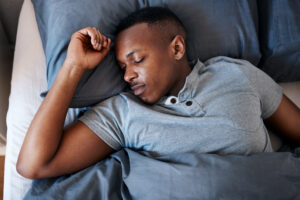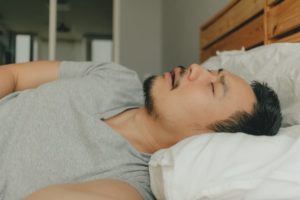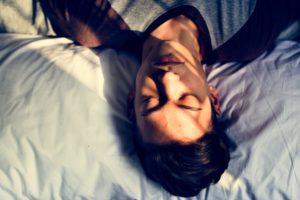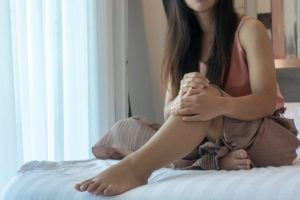When you buy through our links, we may earn a commission. Products or services may be offered by an affiliated entity. Learn more.
Catathrenia: What is Nighttime Groaning and How Do You Treat It?
- Catathrenia is an uncommon sleep-related breathing disorder marked by loud groaning while sleeping.
- Nighttime groaning often disturbs family members or sleep partners.
- Although the causes of catathrenia are uncertain, theories include dysfunctional neurons affecting respiration and small airway structures.
- Treatments can involve CPAP therapy, oral appliances, and tonsillectomy surgeries.
Nighttime groaning, also called catathrenia, is a rare sleep disorder that causes you to groan loudly in your sleep as you exhale. This nighttime groaning happens almost nightly , and you may be unaware that you are groaning. The loud noises you make may be disturbing to a sleep partner or others who hear the sound.
The exact number of people who have catathrenia is unclear. Researchers have reported that between 0.17% and 0.4% of people with sleep problems experience the unusual disorder. Because nighttime groaning is so rare, researchers are still investigating the causes and best treatments of the sleep disorder.
Is Your Nighttime Groaning a Health Risk?
Answer three questions to understand if your nighttime groaning is a concern you should worry about.
What is Nighttime Groaning (Catathrenia)?
Nighttime groaning is a sleep-related breathing disorder. Other common sleep-related breathing disorders include sleep apnea and snoring. Catathrenia can be misdiagnosed as central sleep apnea because the sleep study patterns of both are so similar. Catathrenia also differs from regular snoring because it comes from the larynx, rather than the throat.
The groaning or moaning sounds from catathrenia usually lasts between two seconds and 49 seconds. These moans primarily occur during REM sleep , but can also happen during non-REM sleep.
Previously, catathrenia was classified by the International Classification of Sleep Disorders as a parasomnia. Parasomnias are unusual or undesirable behaviors that happen while falling asleep, during sleep, or as you wake up. Unlike the parasomnia sleep talking, catathrenia does not involve talking or gibberish during sleep.
Experts have noted that catathrenia has characteristics of both sleep-related breathing disorders and parasomnias. Regardless of its classification, catathrenia is a disorder distinct from other parasomnias and sleep-related breathing disorders.
Catathrenia Symptoms
The primary symptom of catathrenia is an almost nightly moaning or groaning sound during sleep that the sleeper does not realize they are making. The sound is often monotone and may be perceived as sullen, gloomy, or sexual in nature . The groaning is made when you exhale and stops when you inhale.
Both adults and children can experience catathrenia. Typically, family members or sleep partners are disturbed by the sound, which prompts the person with nighttime groaning to seek treatment.
Given the low number of cases studied, experts have a limited understanding of other symptoms associated with the disorder. In some case studies, combinations of the following symptoms have accompanied nighttime groaning:
- Snoring
- Dry mouth
- Mouth breathing
- Sleep disruption
- Fatigue
- Morning grogginess
- Morning headache
- Trouble concentrating
Causes of Nighttime Groaning
The exact cause of nighttime groaning is unclear. Some experts hypothesize that the disorder is related to the neurons in the respiratory center of your brain. If these neurons are dysfunctional, they can trigger prolonged exhaling .
Other commonalities among people with catathrenia include small jaws, small upper airways, and breathing that remains constant even as you work to breathe more , called inspiratory flow limitation. Inspiratory flow limitation often signals a sleep-related breathing disorder.
Genetics may also play a factor in the occurrence of catathrenia. One small study of people with catathrenia found that nearly 15% of participants had a family history of the disorder.

Nighttime Groaning Treatments
A number of treatments have been successful in limiting or eliminating nighttime groaning. These treatments range from the use of medical devices to surgeries. People with catathrenia often use multiple forms of treatment to address symptoms of the disorder.
Continuous Positive Airway Pressure (CPAP) Therapy
A CPAP machine is a common form of treatment for people who have obstructive sleep apnea. The medical device delivers pressurized air through a mask you wear as you sleep. This type of therapy ensures the windpipe stays open as you sleep and prevents the airway from collapsing.
Small studies have shown that CPAP is an effective therapy for people with nighttime groaning. The use of CPAP in these cases has also been shown to improve alertness in the daytime.
Oral Appliances
Oral appliances used to treat snoring and obstructive sleep apnea can also be an effective treatment for catathrenia. These appliances are worn only at night and fit like a retainer. The purpose of the oral appliances is to keep the upper airway open.
Tonsillectomy and Adenotonsillectomy
Removal of the tonsils, called a tonsillectomy, or removal of both the tonsils and the adenoids, called an adenotonsillectomy, provides another way to treat nighttime groaning. Several case studies have shown that these surgeries reduce nighttime groaning symptoms. Researchers note that the treatment is especially effective when a device such as a CPAP machine or oral appliance is also used.
When to Contact Your Doctor
Often, people with nighttime groaning do not realize they have the disorder. Instead, a family member or sleep partner may inform them about the sounds they make in their sleep. If you make nighttime sounds that are disturbing to those around you or you experience other symptoms such as disrupted sleep and fatigue, contact your doctor.
If possible, record your symptoms and observations of the groaning sounds. These notes can give your healthcare provider a clearer picture of your experiences. Your doctor can then rule out other similar sleep disorders, such as sleep talking and snoring.
Diagnosis of catathrenia is typically done with polysomnography, or a sleep test. If you have nighttime groaning, your sleep test may indicate abnormal breathing disturbances and limited airflow. Your doctor may also do a physical exam of your head, neck, jaw, and tonsils to identify possible markers associated with nighttime groaning.
Tips for Better Sleep — For You and Your Partner
To achieve better sleep overall, improve sleep hygiene. Proper sleep hygiene includes :
- Keeping a regular sleep-wake schedule, even on the weekends
- Creating a sleep-friendly environment that minimizes light and noise
- Engaging in relaxation before bedtime, such as taking a bath or reading a book
- Exercising during the day
- Avoiding caffeine in the afternoon and evening hours
- Limiting alcohol intake
- Avoiding the use of electronics in the hours before going to sleep
If you have nighttime groaning, treatments such as CPAP therapy or surgical intervention might be able to eliminate your symptoms. Alternatively, if the groaning is only a mild disturbance to your bed partner or family, consider investing in sound-reducing accessories. For example, a white noise machine can cover the sound of groans. Sleep partners could also wear earplugs or noise-canceling headphones.

Still have questions? Ask our community!
Join our Sleep Care Community — a trusted hub of sleep health professionals, product specialists, and people just like you. Whether you need expert sleep advice for your insomnia or you’re searching for the perfect mattress, we’ve got you covered. Get personalized guidance from the experts who know sleep best.
References
13 Sources
-
Petitto, L., Com, G., Jackson, R., Richter, G., & Jambhekar, S. (2019). Catathrenia and treatment with positive airway pressure in the pediatric population. Journal of Clinical Sleep Medicine, 15(12), 1853–1857.
https://pubmed.ncbi.nlm.nih.gov/31855170/ -
Thorpy, M. J. (2012). Classification of sleep disorders. Neurotherapeutics, 9(4), 687–701.
https://pubmed.ncbi.nlm.nih.gov/22976557/ -
Alonso, J., Camacho, M., Chhetri, D. K., Guilleminault, C., & Zaghi, S. (2017). Catathrenia (nocturnal groaning): A social media survey and state-of-the-art review. Journal of Clinical Sleep Medicine, 13(4), 613–622.
https://pubmed.ncbi.nlm.nih.gov/28095968/ -
Vetrugno, R., Lugaresi, E., Ferini-Strambi, L., & Montagna, P. (2008). Catathrenia (nocturnal groaning): What is it? Sleep, 31(3), 308–309.
https://pubmed.ncbi.nlm.nih.gov/18363305/ -
Schwab, R. J. (2020, June). Parasomnias. Merck Manual Consumer Version., Retrieved July 5, 2021, from
https://www.merckmanuals.com/home/brain,-spinal-cord,-and-nerve-disorders/sleep-disorders/parasomnias -
Guilleminault, C., Hagen, C. C., & Khaja, A. M. (2008). Catathrenia: Parasomnia or uncommon feature of sleep disordered breathing? Sleep, 31(1), 132–139.
https://pubmed.ncbi.nlm.nih.gov/18220087/ -
Ortega-Albás, J. J., Diaz, J. R., Serrano, A. L., & de Entrambasaguas, M. (2006). Continuous positive airway pressure as treatment for catathrenia (nocturnal groaning). Neurology, 67(6), 1103.
https://pubmed.ncbi.nlm.nih.gov/17000996/ -
Palombini, L. O., Tufik, S., Rapoport, D. M., Ayappa, I. A., Guilleminault, C., de Godoy, L. B. M., Castro, L. S., & Bittencourt, L. (2013). Inspiratory flow limitation in a normal population of adults in São Paulo, Brazil. Sleep, 36(11), 1663–1668.
https://pubmed.ncbi.nlm.nih.gov/24179299/ -
Oldani, A., Manconi, M., Zucconi, M., Castronovo, V., & Ferini-Strambi, L. (2005). “Nocturnal groaning”: Just a sound or parasomnia? Journal of Sleep Research, 14(3), 305–310.
https://pubmed.ncbi.nlm.nih.gov/16120106/ -
A.D.A.M. Medical Encyclopedia. (2020, January 29). Positive airway pressure treatment., Retrieved July 6, 2021, from
https://medlineplus.gov/ency/article/001916.htm -
American Academy of Dental Sleep Medicine. (2020, June 24). Oral appliance therapy. AADSM.org., Retrieved August 12, 2021, from
https://aadsm.org/oral_appliance_therapy.php -
MedlinePlus: National Library of Medicine (US). (2014, April 14). Healthy Sleep., Retrieved July 6, 2021, from
https://medlineplus.gov/healthysleep.html -
Hysing, M., Pallese, S., Stormark, K., Jakobsen, R., Lundervold, A. J., & Sivertsen, B. (2015). Sleep and use of electronic devices in adolescence: Results from a large population-based study. BMJ Open, 5(1), e006748.
https://pubmed.ncbi.nlm.nih.gov/25643702/



